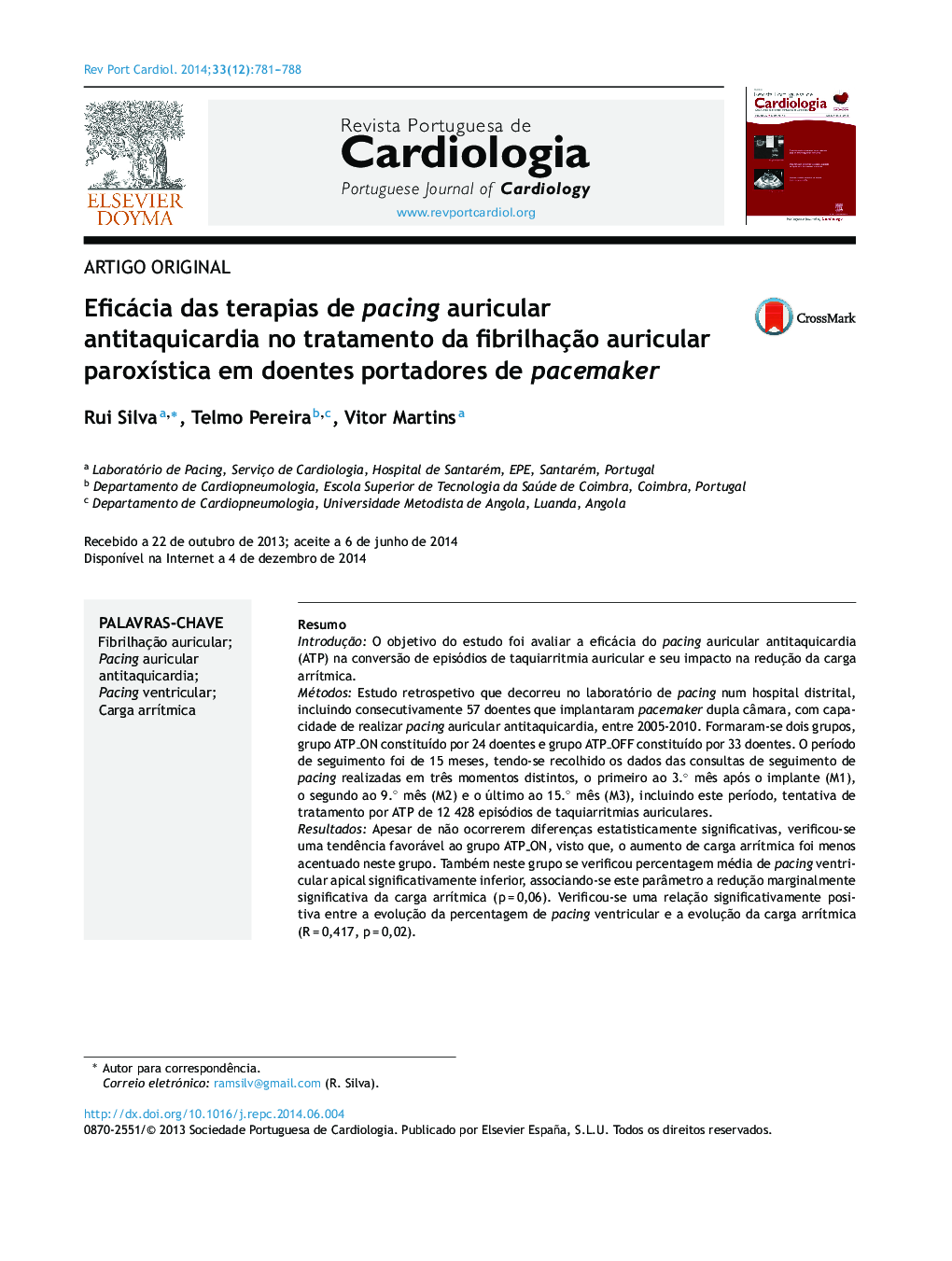| Article ID | Journal | Published Year | Pages | File Type |
|---|---|---|---|---|
| 1125988 | Revista Portuguesa de Cardiologia | 2014 | 8 Pages |
ResumoIntroduçãoO objetivo do estudo foi avaliar a eficácia do pacing auricular antitaquicardia (ATP) na conversão de episódios de taquiarritmia auricular e seu impacto na redução da carga arrítmica.MétodosEstudo retrospetivo que decorreu no laboratório de pacing num hospital distrital, incluindo consecutivamente 57 doentes que implantaram pacemaker dupla câmara, com capacidade de realizar pacing auricular antitaquicardia, entre 2005‐2010. Formaram‐se dois grupos, grupo ATP_ON constituído por 24 doentes e grupo ATP_OFF constituído por 33 doentes. O período de seguimento foi de 15 meses, tendo‐se recolhido os dados das consultas de seguimento de pacing realizadas em três momentos distintos, o primeiro ao 3.° mês após o implante (M1), o segundo ao 9.° mês (M2) e o último ao 15.° mês (M3), incluindo este período, tentativa de tratamento por ATP de 12 428 episódios de taquiarritmias auriculares.ResultadosApesar de não ocorrerem diferenças estatisticamente significativas, verificou‐se uma tendência favorável ao grupo ATP_ON, visto que, o aumento de carga arrítmica foi menos acentuado neste grupo. Também neste grupo se verificou percentagem média de pacing ventricular apical significativamente inferior, associando‐se este parâmetro a redução marginalmente significativa da carga arrítmica (p = 0,06). Verificou‐se uma relação significativamente positiva entre a evolução da percentagem de pacing ventricular e a evolução da carga arrítmica (R = 0,417, p = 0,02).ConclusõesO pacing auricular antitaquicardia converteu 59,7% dos episódios de arritmia auricular, mas não reduziu significativamente a carga arrítmica. Verificou‐se correlação significativamente positiva entre a evolução da percentagem de pacing ventricular e a evolução da carga arrítmica.
IntroductionThe aim of this study was to assess the effectiveness of atrial antitachycardia pacing (ATP) in the conversion of atrial tachyarrhythmia episodes, and its impact in reducing arrhythmic burden.MethodsWe performed a retrospective study in the pacing laboratory of a district hospital of 57 consecutive patients implanted with a dual chamber pacemaker, capable of performing atrial antitachycardia pacing, between 2005 and 2010. The patients were divided into two groups: ATP_ON (n=24) and ATP_OFF (n=33). The follow‐up period was 15 months, with data being collected at three follow‐up consultations: the first at three months after implantation, the second at nine months and the last at 15 months. In this period, there were 12 428 ATP therapies of atrial tachyarrhythmias.ResultsAlthough there were no statistically significant differences, there was a trend in favor of the ATP_ON group, the increase in arrhythmic burden being less marked in this group. The mean percentage of ventricular apical pacing was also significantly lower in this group, which was associated with a marginally significant reduction in arrhythmic burden (p=0.06). There was a significant positive correlation between changes in the percentage of ventricular pacing and changes in arrhythmic burden (r=0.417, p=0.02).ConclusionsAtrial antitachycardia pacing converted 59.7% of episodes of atrial arrhythmia, but did not significantly reduce arrhythmic burden. There was a significant positive correlation between changes in the percentage of ventricular pacing and changes in arrhythmic burden.
